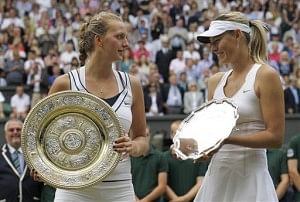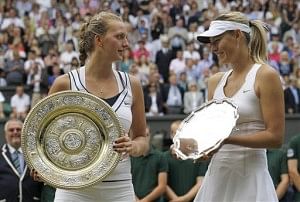
Wimbledon 2011: The Future Is Here
Yes, it will always be foolish to herald the birth of a long-term superstar based on just one Grand Slam performance. No, that’s not going to stop me from predicting that Petra Kvitova, the soft-spoken slayer from the Czech Republic who won her first Major yesterday by defeating Maria Sharapova 6-4, 6-3 in the Wimbledon final, has the potential to be one of the greatest players of all time.
It sure seemed that Kvitova was aware of just how many expectant words were being written about her as she sent down a thundering ace (take note, bashers of women’s tennis!) on match point, because her victory celebration was not even close to what you’d imagine a first-time winner to indulge in. There were no looks of disbelief or uncontrollable surges of nervous energy from her; true, she did sink to her knees and cover her face with her hands, but in less than an instant after that she was back to her serene, composed self. Armed with the knowledge that she had carved a special place for herself in the sport, Kvitova rose from the ground to her full height of 6’1” and steadily looked around her with a calm contentment the like of which you’d be lucky to find in seasoned champions. As she accepted the Venus Rosewater dish and gave her endearing winner’s speech in broken English, she kept adding to the feeling that, finally, the WTA had found its savior – the champion female player who could be relied on to step up at the right times and take what is rightfully hers without getting overcome by emotion or nerves or whatever the heck has been assailing the top female players lately.
What exactly is so special about Kvitova? There’s a lot to like about her game, certainly. She serves big, possesses effortless power on her groundstrokes and has an unwavering attack-at-first-opportunity mindset, the value of which can only be affirmed by the greatest players in history. And did I mention she’s a lefty who makes great use of that quirky ability, perhaps as effectively as Rafael Nadal? That wide serve in the ad-court to the right-hander’s backhand sure does have the potential to be a perennial head-scratcher for her opponents in the years to come. The blistering 125 mph aces that Sabine Lisicki kept sending down with incredible regularity were the talk of the tournament, but Kvitova’s silent thunderbolt serves were doing some heavy damage of their own, particularly because of Kvitova’s unrelenting consistency in dispatching weak returns for winners.
Ah, those winners! There doesn’t seem to be a single square inch on the tennis court from where Kvitova can’t hit an eye-popping blast that the opponent has no hope of getting to even if she were playing on skates. In her semifinal against Victoria Azarenka, who’s no slouch at the baseline herself, Kvitova’s winner count outnumbered that of Azarenka by the barely-believable margin of 40 to 9. In the final, playing against Sharapova, a player who usually overcomes her rash of errors by bashing winners left, right and centre, Kvitova’s winner count almost doubled that of her opponent. Big Babe tennis just got bigger.

Petra Kvitova and Maria Sharapova with their shining new Wimbledon trophies
Despite all of her physical gifts, a Wimbledon trophy, or any Slam title, for that matter, would have forever remained out of Kvitova’s grasp if she didn’t have the mental qualities to complement her imposing game. But the Czech acquitted herself spectacularly in that department too. She used the backhand slice effectively to keep Sharapova constantly guessing and off-balance. And she has the knack of spotting the exact moment in a rally at which to pull the trigger and go for the big shot; she basically outgunned and outmaneuvered Sharapova from the baseline yesterday, a feat that is nothing to sneeze at. Moreover, Sharapova had been returning serve like a woman possessed the entire tournament, a fact that Kvitova not only recognized, but also countered smartly by repeatedly hitting body serves instead of conventional line-grazing ones; the ploy worked like a charm, as Sharapova kept getting handcuffed without any angles to work with. And then there are those volleys. Did we actually witness a ball-basher who knew when to come to the net and end points with something resembling finesse? It’s no wonder Martina Navratilova was purring about Kvitova’s incredible promise both before and after the final.
It’s not just the tactical acumen that Kvitova displayed yesterday that was such a revelation though. The sheer mettle she showed in refusing to let the occasion or the fear of wasting an opportunity get to her was as refreshing as her excellent all-court game. Serving at 5-3 in the first set, she put in a commanding serving performance and walked away with the set before Sharapova had the time to scream her way back into contention. Kvitova did lose her way a little in the second set, spraying shots alarmingly wide to repeatedly lose her serve, but that could partly be attributed to Sharapova raising her intensity by a notch or two. When it really mattered, when it was all on the line at 5-4 in the second, many would have expected Kvitova to lose her nerve and allow Sharapova to make a roaring (or shrieking) comeback into the match. This, after all, was Centre Court, and Kvitova, on the verge of winning her maiden Major, was up against a Sharapova in full desperation mode. But what does Kvitova do? Confidently close out the match by holding at love, that’s what. It was, without a doubt, a performance that would have made even the likes of Serena Williams proud.
So we’ve established that Kvitova is the most real of all real deals. But where does Sharapova go from here? She didn’t exactly stink up the joint in the final, although the figure of 6 double faults, a couple of which came at crucial junctures, may signify the deal-breaker, the reason why it’s taken so long for her to make a full comeback from her shoulder injury. Sharapova did well to withstand some real pressure from Brit upstart Laura Robson in the 2nd round, and the way in which she overcame her serving woes to defuse the Lisicki train in the semifinals is worthy of respect. But it was always an uphill struggle for her through the fortnight, even against opponents nowhere close to her in stature or skill. She was anointed the overwhelming favorite going into the final by most analysts, but that optimism was born more out of her career record than any particular brilliance she showcased in the tournament. Still, this tournament has given reason to be hopeful of a more complete turnaround in the near future. Sharapova has managed to change the experts’ opinion from ‘She’ll never win another Slam’ to ‘She won’t win another Slam unless she fixes her serve’. That has got to be seen as a positive.
For the moment, though, it’s all about Kvitova and her seemingly invincible game (when it’s working). The logical question that follows, of course, is how consistently and for how long she can keep her game working. A month? A year? A career? If yesterday’s final showing (which came exactly a year after she stormed through the draw to lose a tight semifinal against Serena Williams) is any indication, Kvitova is here to stay. And that’s a prospect that, while spelling doom and despair for every other female player in the world, must surely come as a much-needed shot in the arm for the WTA; the days of headless parity in the game may soon be over.
I have seen the future of women’s tennis, and it is called Petra Kvitova.